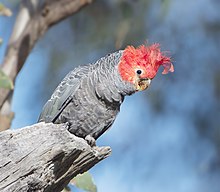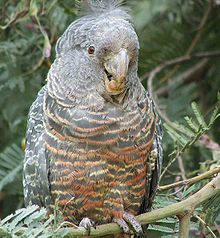Gang-gang cockatoo
| Gang-gang cockatoo | |
|---|---|

| |
| Adult male | |

| |
| Female | |
| Scientific classification | |
| Domain: | Eukaryota |
| Kingdom: | Animalia |
| Phylum: | Chordata |
| Class: | Aves |
| Order: | Psittaciformes |
| Family: | Cacatuidae |
| Genus: | Callocephalon Lesson, RP,1837 |
| Species: | C. fimbriatum
|
| Binomial name | |
| Callocephalon fimbriatum (Grant, J,1803)
| |

| |
| Range ofC. fimbriatum | |
Thegang-gang cockatoo(Callocephalon fimbriatum) is a parrot found in the cooler and wetter forests and woodlands ofAustralia,particularlyalpinebushland.It is the only species placed in thegenusCallocephalon.Mostly mild grey in colour with some lighter scalloping (more pronounced and buffy in females), the male has a red head andcrest,while the female has a small fluffy grey crest. It ranges throughout south-eastern Australia. The gang-gang cockatoo is the faunal emblem of theAustralian Capital Territory.It is easily identified by its distinctive call, which is described as resembling a creaky gate, or the sound of acorkbeing pulled from a wine bottle.
The namegang-gangcomes from aNew South WalesAboriginallanguage, probably from one of the coastal languages, although possibly fromWiradjuri.It is probably an onomatopoeic name.[2]
Taxonomy
[edit]In 1803 the British Royal Navy officerJames Grantincluded an illustration of the gang-gang cockatoo in his book describing a voyage to thecolony of New South Walesin Australia. Grant coined thebinomial namePsittacus fimbriatus.[3]The gang-gang cockatoo is now the only species placed in thegenusCallocephalonthat was introduced in 1837 by the French naturalistRené Lesson.[4][5]Thetype localityis theBass Riverin the state ofVictoria.[6]The specific epithet is fromLatinfimbriatameaning "fringed". The genus name combines theAncient Greekkallosmeaning "beauty" andkephalēmeaning "head".[7]The species ismonotypic:nosubspeciesare recognised.[5]
The classification of the gang-gang cockatoo has always been controversial due to the unusual appearance and coloration of the bird, especially itssexual dichromatism.The gang-gang cockatoo was thought to be a distinctive early offshoot of the Calyptorhynchinae (black) cockatoos.[8]However, more recent molecular phylogenetic analysis places it in the Cacatuinae clade, not the Calyptorhynchinae, and having diverged from thepalm cockatoo(Probosciger aterrimus).[9]
Description
[edit]The gang-gang cockatoo is 32–37 cm (13–15 in) in length with a 62–76 cm (24–30 in) wingspan,[10]and weighs 230–334 grams.[11]They are grey birds with wispy crests. The head and crest is bright red in males, but dark grey in females. The edges of feathers in underparts have edges of yellow or pink. The edges of feathers on upperarts are slightly paler grey than the rest of the feather, which makes the bird look somewhat barred. Juvenile males can be distinguished by their brighter crowns and shorter crests, but otherwise look similar to the adult female. The birds are not easily mistaken for other cockatoos, but while in flight may resemble theGalah.Gang-gangs are very social birds, but not overly noisy.[12]
Distribution and habitat
[edit]Gang-gangs are endemic to coastal regions of south-eastern Australia. They used to inhabitKing Islandoff ofTasmania,but have become extinct there. They are an introduced species onKangaroo Island.Gang-gangs prefer forests and woodlands in the mountains, with dense shrub understories. They migrate short distances during winter into more open habitats, but must migrate back to denser forests to breed, because they need tall trees in order to build nests.[12]
Behaviour and ecology
[edit]Breeding habits
[edit]Unlike most othercockatoos,gang-gangs nest in young, solidtrees,they often nest near water.[13]The females using their strongbeaksto excavate nesting cavities. Gang-gangs are monogamous. The breeding season lasts from spring to summer. The birds will lay 2-3 white eggs, the incubation period is 4 weeks and both sexes take care of the young.[13][14]
Diet
[edit]They forage in canopies mostly feed on the flowers and buds of eucalypts, with other sources of food coming from berries, cones and wattle flowers.[15][16][13][14]
Status
[edit]Loss of older, hollow trees and loss of feeding habitat across south-eastern Australia through land clearing has led to a significant reduction in the numbers of this cockatoo in recent years. As a result, the gang-gang is now listed as vulnerable in New South Wales.[17]It is protected as a vulnerable species under theBiodiversity Conservation Act 2016(NSW).[18]This protection status as a threatened species makes it a Tier 1 criminal offence for a person or corporation to knowingly damage the bird's habitat.[19]Damage is defined to include "damage caused by removing any part of the habitat".[20]Habitat is defined to include "an area periodically or occasionally occupied by a species".[21]
In July 2021, an AustralianDepartment of the Environment and Energyspokesperson stated the population has declined by approximately 69% in the last three generations, or 21 years and in addition to this decline, the species has suffered direct mortality and habitat loss during the2019–20 Australian bushfire season.Between 28 and 36 per cent of the species' distribution was impacted by the fires.[22]As a result, it is set to be listed as endangered under thethreatened fauna of Australia.[23]
Gallery
[edit]-
A female gang-gang cockatoo eatingSchinus molleseeds
-
Male in the Blue Mountains
-
Male eatingAcacia baileyanaseeds
-
Two immature birds at New Buildings, NSW, Australia: The male is on the left and the female on the right.
References
[edit]- ^BirdLife International (2022)."Callocephalon fimbriatum".IUCN Red List of Threatened Species.2022:e.T22684755A210869419.Retrieved22 July2022.
- ^Gray, Jeannie; Fraser, Ian (2013).Australian Bird Names: A Complete Guide.Collingwood, VIC, Australia: CSIRO Publishing. p. 127.ISBN9780643104709.
- ^Grant, James(1803).The narrative of a voyage of discovery, performed in His Majesty's vessel the Lady Nelson, of sixty tons burthen with sliding keels, in the years 1800, 1801, and 1802, to New South Wales.London: T. Egerton. Plate opposite page 135.
- ^Lesson, René(1837)."Histoire Naturelle".InBougainville, Hyacinthe de(ed.).Journal de la navigation autour du globe, de la frégate La Thétis et de la corvette L'Espérance, pendant les années 1824, 1825 et 1826: publié par ordre du roi sous les auspices du Département de la marine.Vol. 2. Paris: A. Bertrand. pp. 299–351 [311–318].
- ^abGill, Frank;Donsker, David;Rasmussen, Pamela,eds. (January 2021)."Parrots, cockatoos".IOC World Bird List Version 11.1.International Ornithologists' Union.Retrieved5 March2021.
- ^Peters, James Lee,ed. (1937).Check-List of Birds of the World.Vol. 3. Cambridge, Massachusetts: Harvard University Press. p. 173.
- ^Jobling, James A. (2010).The Helm Dictionary of Scientific Bird Names.London: Christopher Helm. pp. 85, 159.ISBN978-1-4081-2501-4.
- ^Brown, D.M.; Toft, C.A. (1999). "Molecular systematics and biogeography of the cockatoos (Psittaciformes: Cacatuidae)".Auk.116(1): 141–157.doi:10.2307/4089461.JSTOR4089461.
- ^White, N.E. (2011)."The evolutionary history of cockatoos (Aves: Psittaciformes: Cacatuidae)".Molecular Phylogenetics and Evolution.59(3): 615–622.Bibcode:2011MolPE..59..615W.doi:10.1016/j.ympev.2011.03.011.PMID21419232.
- ^"Gang-gang Cockatoo – profile".www.environment.nsw.gov.au.
- ^"Conservation Advice for Callocephalon fimbriatum (Gang-gang Cockatoo)"(PDF).p. 3.Retrieved17 August2023.
- ^ab"Gang-gang Cockatoo | BIRDS in BACKYARDS".www.birdsinbackyards.net.Retrieved2019-06-14.
- ^abc"Gang-gang Cockatoo"(PDF).NSW Gov.December 2008.
- ^ab"Gang-gang Cockatoo".The Australian Museum.Retrieved2024-04-03.
- ^"Get to know the gang-gang cockatoo".ANU College of Science.Retrieved2024-04-03.
- ^Mulvaney, Michael, and Isobel Booksmythe. "Gang-gang Cockatoo diet as assessed by camera images and written records."https://absa.asn.au/wp-content/uploads/2023/04/4_V47_Pg8-15_GangGangCockatoo_V2.pdf
- ^Hughes, Lesley (2005)."Gang-gang Cockatoo – vulnerable species listing".NSW Scientific Committee – final determination.New South Wales Office of Environment & Heritage.Retrieved21 November2011.
- ^Biodiversity Conservation Act 2016(NSW), Schedule 1: Part 3 Vulnerable species
- ^Biodiversity Conservation Act 2016(NSW), s.2.4
- ^Biodiversity Conservation Act 2016(NSW), s.1.6
- ^Biodiversity Conservation Act 2016(NSW), s.1.6
- ^Brown, Andrew (24 July 2021)."Gang-gang cockatoo set to be listed on threatened species list as endangered".The Canberra Times.Australian Community Media.Retrieved2 August2021.
- ^"Gang-gang cockatoo to become threatened species after large drop in bird numbers".The Guardian.2022-03-01.Retrieved2022-03-30.
- Flegg, Jim (2002).Photographic Field Guide: Birds of Australia.Sydney & London: Reed New Holland.ISBN1-876334-78-9.
External links
[edit]- Gang-gang Cockatoo Species ProfileatWorld Parrot Trust Parrot Encyclopedia
- BirdLife species factsheet forCallocephalon fimbriatum
- Gang-gang cockatoo on the Atlas of Living Australia
- "Callocephalon fimbriatum".Avibase.
- "Gang-gang cockatoo media".Internet Bird Collection.
- Gang-gang cockatoo photo galleryat VIREO (Drexel University)
- Interactive range map ofCallocephalon fimbriatumatIUCN Red List maps
- Audio recordings of Gang-gang cockatooonXeno-canto.





